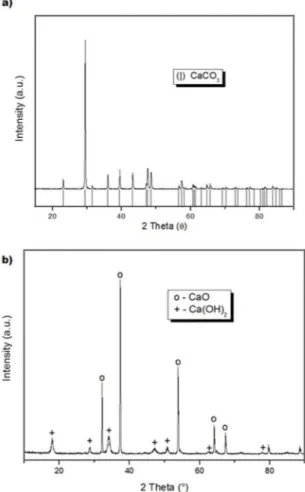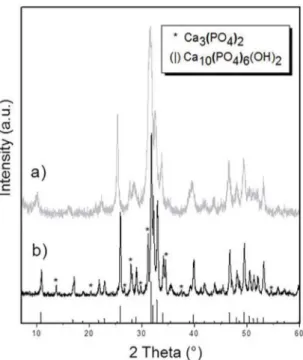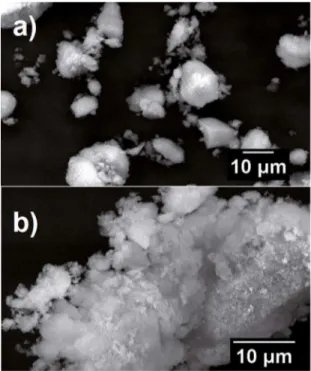Ostrich Eggshell as an Alternative Source of Calcium Ions for Biomaterials Synthesis
Lorena Batista Calimana,d, Sidney Nicodemos da Silvab, Janaína Accordi Junkesc,*,
Viviana Possamai Della Sagrillod
Received: May 12, 2016; Revised: September 19, 2016; Accepted: January 02, 2017
Ostrich eggshells are a potentially abundant and a high purity and low cost source of calcium to
produce β-Tricalcium Phosphate (β-TCP) and Hydroxyapatite (HA), important calcium phosphates used as biomaterials. Here, we use a wet precipitation procedure to synthesize these phosphates using ostrich eggshells as a source of calcium ions. The biphasic precipitated powder, calcined at 800°C, is a mixture of both Hydroxyapatite and β-Tricalcium Phosphate, also known as the biomaterial Biphasic Calcium Phosphate (BCP). Physico-chemical properties of the inal powder product show water and CO3
2- groups absorbed in the particles surface, 0.1 to 100 µm particles size distribution and 11.70 m2/g of speciic surface area.
Keywords: Hydroxyapatite, β-TCP, biomaterials, ostrich eggshells, recycling
* e-mail: janajunkes@gmail.com
1. Introduction
Biomaterials are synthetic or natural materials used
as replacement parts of a biologic system to play a certain
role in contact with a living tissue. Calcium phosphates
are important bioactive and bioresorbable biomaterials. A bioactive material will slowly dissolve when in contact with a living tissue, forming a layer of biological apatite before reaching the bone, and forming a direct bond to the bone. A reabsorbable material instead will dissolve and allow that a new tissue grows inside its irregularities cavities, not
necessarily interacting with the bone. Dense hydroxyapatite is an example of a bioactive material while Biphasic Calcium Phosphate (a mixture of HA and β-TCP) porous scafolds are bioresorbable materials. That is the reason why these two phosphates are the most used biomaterial in the medical ield1.
Hydroxyapatite (HA) is the inorganic component of teeth
and bones and is the most popular calcium phosphate ceramic
for medical use due to its excellent biocompatibility, good
corrosion resistance and chemical stability. It is especially in demand as a biomaterial to restore bone defects2. Although
other synthetic bone substitutes have been considered, the high costs and technological challenges involved in the engineering of biomaterials are frequently prohibitive3.
For this reason, HA remains the most frequent choice for
bone replacement.
Wet chemical precipitation is the most commonly used
procedure for HA synthesis due to its simplicity and easy
large-scale application4. In this procedure the temperature
of the liquid medium does not exceed 100°C leading to the
precipitation of nanometric crystals, with crystallinity and
Ca/P ratio strongly dependent on preparation conditions5. The
total cost and efectiveness of this method strongly depends
on the use of quality raw materials that act as a source of calcium and phosphorus precursors4. One potential low cost
source material is eggshell, which can be harvested after hatching with virtually no environmental impacts.
Tricalcium phosphate (Ca3(PO4)2) exits in two allotropic
forms: α e β. Its Ca/P ratio is 1.5, slightly smaller the HA. β-TCP can not be precipitated from aqueous solutions, it is only prepared from the calcination of Ca-deicient HA or
by solid state reactions6.
The physic-chemical properties of eggshells have attracted scientiic interest as natural calcium sources for biodiesel
production7 and Chen et al. (2014) recently utilized ostrich
eggshells to produce heterogeneous solid catalysts8. Eggshells
of diferent bird species have similar chemical properties, being very rich in calcium carbonate CaCO3. The largest egg of any
living bird is that of the ostrich (Struthio camelus), with medium weight of 1.5 kg, a typical size of 16 × 12 cm and shell thickness
of 2mm3,9 about 20-25 times bigger than a chicken egg. A good
breeding group of ostriches produces eggs with a fertility rate of
at least 90%. During the irst laying season, females lay between
10 and 30 eggs with this rate later increasing to between 40 and
70 eggs. Moreover, when kept healthy and in good conditions they can remain productive for 25-35 years9.
a Department of Metallurgical and Materials Engineering, University of São Paulo, Av. Prof. Mello
Moraes 2463, 05508-030, São Paulo, SP, Brazil
b Department of Materials Engineering, Federal Center of Technology Education of Minas Gerais -
CEFET-MG, Av. Amazonas 5253, 30421-169, Belo Horizonte, MG, Brazil
c University Center Tiradentes - UNIT, Av. Comendador Gustavo Paiva 5014, 57038-000, Maceió,
AL, Brazil
Discarded eggshells are a potential environmental issue in poultry farming, since they can occupy an enormous volume and can harbor bacteria and fungi due to the high
content of organic matter. The decomposition of this matter
is a potential source of diseases in addition to the terrible smell it produces10. In this study it is described the production
of Biphasic Calcium Phosphate from ostrich eggshells by
a wet chemical procedure with the aim of producing a high quality product and reducing agricultural waste.
2. Material and Methods
2.1. Precipitation
Ostrich eggshells were washed and milled (Marconi, MA590) for 30 minutes and calcined (EDG, FI-PQ) at 800°C for 3 hours to decompose organic matter and calcium carbonate. The 5.6g of the resulting powder was dissolved in distilled water (150 mL) in order to obtain a Ca(OH)2
suspension.
Wet chemical precipitation aiming HA synthesis occurs
through a reaction between phosphate anion and calcium
salts or an acid-base reaction:
440, Pt-Au coat). Particle size distribution was determined by a laser difraction analyzer after ultrasound preparation (Mastersizer 2000).
3. Results and Discussion
The ostrich eggshells were crushed manually, then milled
for 30 minutes and its composition was determined by XRD
(Figure 1a). The only inorganic phase present was calcium carbonate (International Centre for Difraction Data - ICDD, 86-2334). After calcination, the XRD (Figure 1b) analysis
indicated that all the carbonate had decomposed into calcium
oxide (ICDD, 37-1497). This was later dissolved in distilled water to prepare a calcium hydroxide suspension for the
synthesis reaction.
( )
Ca OH
H PO
Ca
PO
OH
H O
10
6
18
1
aq aq
s
2 3 4 2
10 4 6 2 2
"
+
+
Q
Q
Q
Q
QQ
Q
V
V
V
V
VV
V
The acid-base precipitation was carried out by stirring and heating (40°C) the Ca(OH)2 suspension, while 30 mL
of a 2M solution of orthophosphoric acid was added, drop
by drop (1mL/min). These quantities would result in a 1.67 Ca/P ratio phosphate. The pH value was maintained at 10 by adding small aliquot of NH4OH solution periodically. The
resulting precipitate was vigorously stirred (magnetic stirrer) and heated (40°C) for 24 hours. After vacuum iltration and drying (100°C/24h), it was calcined (EDG, FI-PQ) at 800°C for 3 hours.
2.2 Characterization
The powder (precipitate) was characterized using speciic surface area (SSA) measurements B.E.T. method (Micromeritics Gemini III 2375 Surface Area Analyzer and VacPrep 061 unit) and by X-ray difraction (Philips X’Pert X-ray Difractometer with Cu Kα radiation, 40 kV and 30 mA from 3 to 120°). The surface characteristics of the particles were determined by Fourier Transform Infrared Spectroscopy using the DRIFT accessory (Thermo-Nicolet - Magna 560 from 400 to 4000 cm-1 and 4 cm-1 resolution).
Chemical composition was analyzed by Inductively Coupled Plasma - Atomic Emission Spectroscopy (ICP) (Thermo iCAP 6300 Duo), and powders images were obtained by Scanning Electron Microscope (Leica Cambridge, Stereoscan
Figure 1: XRD patterns: (a) Milled ostrich eggshell and (b)
calcined powder.
The dried inal powder obtained by precipitation was analyzed by XRD and the patterns matched with HA (ICDD, 9-432). No other phases were observed (Figure 2a).
Figure 2: (a) Precipitate powder and (b) calcined powder XRD
patterns.
as β-Tricalcium Phosphate − β-TCP (ICDD, 9-169). The
appearance of this phase indicates that the precipitated
powder was a calcium-deicient Hydroxyapatite (d-HA). Obtaining a calcium deicient HA is a common characteristic
of the wet chemical precipitation, even in ideal conditions6.
The β-TCP appearance results from calcium-deicient HA instability above 700°C. As previously reported11-13,
d-HA (Ca/P ratio between 1.5 and 1.67), when heated to temperatures higher than 700°C, decomposes into a biphasic powder of stoichiometric HA and β-TCP. Indeed, Mortier
et al.11 observed that d-HA (Ca
10-x(HPO4)x(PO4)6-x(OH)2-x
0<x<1) phase transformations occur at diferent temperatures,
as follows:
( )
C
I
Ca
HPO
PO
OH
nH O
250
<
x x x x
10 4 4 6 2 2
.
$
c
-
Q
V
Q
V
-Q
V
-( )
C
II
Ca
HPO
PO
OH
H O
n
x H O
250
700
x x x x x
10 4 4 6 2 2 2
.
$
c
+
--
Q
V
Q
V
-Q
V
-Q
V
Q
V
(
)
C
III
Ca
P O
PO
OH
xH O
700
800
x x x x
10 2 7 4 6 2 2
.
$
c
--
Q
V
Q
V
-Q
V
x Ca
PO
OH
xCa PO
xH O
1
-
10 4 6 2+
3
3 4 2+
2Q
V
Q
V
Q
V
Q
V
Stoichiometric HA is the major phase in the inal powder. The phase proportion was determined by Rietveld reinement: HA represented 79.1%w and β-TCP 20.9%w. As soon as it was evidenciated that precipitated HA was slightly calcium deicient, a chemical analysis was performed to determine the Ca/P ratio (Table 1).
Table 1. Chemical analysis.
Ca P
% weight 30.8073 ± 0.0001 14.8774 ± 0.0001 Atomic weight
(g/mol) 40.1 31.0
Sample molar content
(100g) 0.77 0.48
Ca/P ratio 1.60
Chemical analysis of precipitated HA by ICP OES resulted in a 1.60 Ca/P ratio, which is consistent with previous works11-13 that indicate that HA obtained by wet
chemical routes is typically calcium deicient with a Ca/P
ratio between 1.5 and 1.67.
The obtained biphasic powder has potential importance for biomedical applications combining the diferent behaviors
of these materials when in contact with organic tissue.
Speciically, the HA and β-TCP are major constituents of an extensively used biomedical material named Biphasic Calcium Phosphate (BCP). The IR analysis compared the calcined and uncalcined samples spectra (Figure 3). Bands at 1033-1038 and 1089-1094 cm-1; a medium intensity band around 962 cm-1; bands located at 565-567 and 601-603 cm-1; and a low-intensity band around 472-474 cm-1 are
characteristic of phosphate group (PO4
3-) of HA.
Figure 3: FTIR spectra of (a) calcined and (b) uncalcined samples.
Bands at 1650 and 3410 cm-1 indicate the presence
of adsorbed water in surfaces of the HA particles. Bands at 877, 1411-1421 and 1453-1467 cm-1 were assigned as
CO3
2-, which is caused by an atmosphere-opened reaction
After calcination, it is possible to observe a decrease in the intensity of these bands because adsorbed groups tend to be
eliminated at high temperatures. Biological apatites are usually carbonated and slightly calcium deicient14. Consequently,
the presence of these groups does not prejudice the use of
this biphasic powder as a biomaterial.
After heating to 800°C, there is a clear transformation of d-HA into stoichiometric HA and β-TCP. Analysis of the spectrum indicates bands of both compounds: the OH- characteristics bands at 3571-3576 and 630-633 cm-1 and
the characteristic band of β-TCP at 944 cm-1. The OH- band at 630 cm-1 is a well known characteristic of HA, a well
deined triplet which shows the PO4
3- bonds at 601 and 570
cm-1 and the –OH bond to the apatite group at 630 cm-1.
SEM images with diferent approximations show round shaped grains and micrometric granulometry (Figure 4). Particles shape and size are directly inluent in the inlammatory response and bone formation. They should not be needle-shaped form since it is not the propitious
environment for bone cells development. Round particles with smooth surfaces are preferred15, because they induce
a short-duration inlammatory response, followed by the
desired incorporation of the biomaterial to the host tissue. On
the other hand, needle-shaped particles cause granulomatous inlammation, accompanied by the material collapse and
reabsorption by the surrounding tissues.
Figure 4: Image (a) show precipitated powders and (b) calcined
powders.
Particle size was estimated by laser granulometry to vary from 0.1 to 100 µm (Figure 5) and the calcined powder speciic surface area is 11.70 m²/g. Bioactive materials
Figure 5: Biphasic powder particle size distribution.
such as HA, which act like substrate to bone tissue growth,
are desirable to present the larger contact area possible
facilitating the tissue growth. Produced BCP present a higher speciic surface area than most of biomaterial for odontology implants tested by Conz16 as well as smallest
particles size distribution, contributing to more surface to
act as substrate.
The powder’s combination of physical characteristics is biomedically valuable, since efective action of bioactive
materials depends on a large contact area with the biological
medium (bone tissue). Thus, powders with larger surface
area should be better able to promote bone growth.
4. Conclusions
Ostrich eggshell is a low cost and abundant and pure source of calcium ions for the synthesis of biomaterials,
producing a biomedically valuable biphasic powder of HA and β-TCP according to the desirable features a biomaterial
should present listed by the literature. It was described a procedure that could be used to transform agricultural
waste (ostrich eggshells) into an economically valuable high-quality new product, directly reducing discard and
associated environmental impacts. Indeed, no other wastes
were produced during HA synthesis.
5. Acknowledgments
The authors thanks CAPES, for the inancial support;
Santa Esmeralda Struthio Farm, for the ostrich eggshell supply
for this work; LABPETRO-UFES, PMT-USP, DEMAT-CEFET-MG, LEEAA-USP for the characterization analysis.
6. References
1. Ribeiro C. Obtenção e caracterização de biocerâmicas porosas
à base de fosfato de cálcio processadas com a utilização de
2. Petrov OE, Dyulgerova E, Petrov L, Popova R. Characterization of
calcium phosphate phases obtained during the preparation of sintered
biphase Ca-P ceramics. Materials Letters. 2001;48:(3-4):162-167. 3. Dupoirieux L. Ostrich eggshell as a bone substitute: a preliminary
report of its biological behaviour in animals – a possibility in facial reconstructive surgery. British Journal of Oral and Maxillofacial Surgery. 1999;37(6):467-471.
4. Ahmed S, Ahsan M. Synthesis of Ca-hydroxyapatite Bioceramic from Egg Shell and its Characterization. Bangladesh Journal of Scientiic and Industrial Research. 2008;43(4):501-512. 5. Suchanek W, Yoshimura M. Processing and properties of
hydroxyapatite-based biomaterials for use as hard tissue replacement
implants. Journal of Materials Research. 1998;13(1):94-117.
6. Dorozhkin SV. Calcium Orthophosphates in Nature, Biology and
Medicine. Materials.2009;2(2):399-498.
7. Khemthong P, Luadthong C, Nualpaeng W, Changsuwan P, Tongprem P, Viriya-empikul N, et al. Industrial eggshell wastes as the heterogeneous catalysts for microwave-assisted biodiesel
production. Catalysis Today. 2012;190(1):112-116.
8. Chen G, Shan R, Shi J, Yan B. Ultrasonic-assisted production of biodiesel from transesteriication of palm oil over ostrich eggshell-derived CaO catalysts. Bioresource Technology. 2014;171:428-432. 9. Tan TH, Abdullah MO, Nolasco-Hipolito C, Tauiq-Yap YH. Waste
ostrich- and chicken-eggshells as heterogeneous base catalyst for biodiesel production from used cooking oil: Catalyst characterization
and biodiesel yield performance. Applied Energy. 2015;160:58-70.
10. Rivera EM, Araiza M, Brostow W, Castaño VM, Dı́az-Estrada JR, Hernández R, et al. Synthesis of hydroxyapatite from
eggshells. Materials Letters. 1999;41(3):128-134.
11. Mortier A, Lemaitre J, Rouxhet PG. Temperature-programmed characterization of synthetic calcium-deicient phosphate
apatites. Thermochimica Acta. 1989;143:265-282.
12. Mostafa NY. Characterization, thermal stability and sintering of hydroxyapatite powders prepared by diferent routes. Materials Chemistry and Physics. 2005;94(2-3):333-341.
13. Raynaud S, Champion E, Bernache-Assollant D, Laval JP. Determination of Calcium/Phosphorus Atomic Ratio of Calcium Phosphate Apatites Using X-ray Difractometry. Journal of the American Ceramic Society. 2001;84(2):359-366.
14. Vallet-Regí M, González-Calbet JM. Calcium phosphates as
substitution of bone tissues. Progress in Solid State Chemistry.
2004;32(1-2):1-31.
15. Dalapicula SS, Vidigal Junior GM, Conz MB, Cardoso ES. Características físico-químicas dos biomateriais utilizados em enxertias ósseas. Uma revisão crítica. ImplantNews.
2006;3(5):487-491.
16. Conz MB, Campos CN, Serrão SD, Soares GA, Vidigal Junior GM. Caracterização físico-química de 12 biomateriais utilizados como enxertos ósseos na Implantodontia. ImplantNews.


